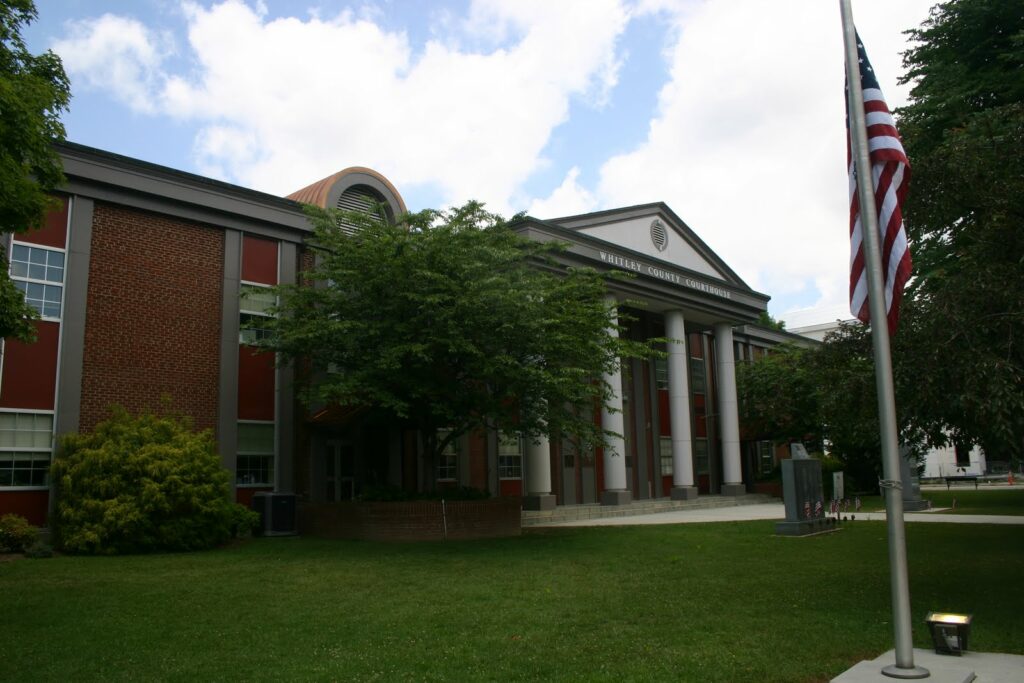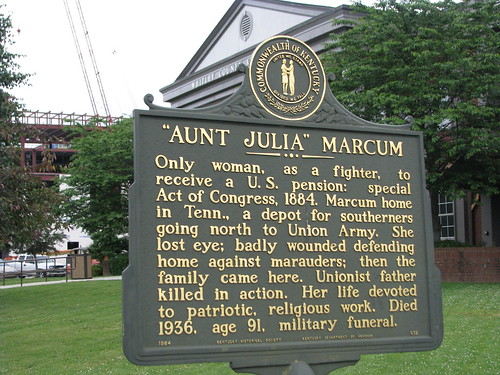
Driving into Williamsburg, you see all of these towers and cupolas peeking up above the trees. I immediately started thinking about how awesome this courthouse was going to look. Unfortunately, all of these towers are a part Cumberland College, and the courthouse square was relatively boring and deserted on this Saturday morning. Even Cumberland College’s football field has cupolas on the press box.
The courthouse pictured above is the fourth to sit on this site. Interestingly, the original name of Williamsburg was actually “Whitley Courthouse.” Come on pioneers…you guys could do better than that.
As I believe I’ve noted before, the largest city in Whitley County is actually Corbin, which in fact sits in three counties and is the county seat of none of them…which is kind of insane when you think about it. What would have been so devastating about one big county with Corbin in the middle?
Tag: Whitley
No Destination: “Aunt Julia” Marcum
 |
| Historic Marker, Williamsburg, Ky. |
According to the Kentucky Encyclopedia, Julia Ann Marcum was raised in Tennessee. Her family sympathized with the Union cause and for this their home was attacked in September 1861. Julia fought off a Confederate soldier with an ax until her father shot the soldier dead, but during this fight Julia was badly wounded. Although she worked for a time as a schoolteacher, she ultimately became permanently disabled as a result of her war wounds. She moved to Williamsburg upon her retirement and became the only female ever admitted to the Grand Army of the Republic. Historic Marker #672 reads:
Only woman, as a fighter, to receive a U.S. pension: special Act of Congress, 1884. Marcum home in Tenn., a depot for southerners going north to Union army. She lost eye; badly wounded defending home against marauders; then the family came here. Unionist father killed in action. Her life devoted to patriotic, religious work. Died in 1936, age 91, military funeral.
No Destination: University of the Cumberlands
 |
| Bell Tower at the University of the Cumberlands, Williamsburg, Ky. |
Originally founded as the Williamsburg Institute in 1889 and renamed to Cumberland College in 1913, the University of the Cumberlands took its present name in 2005. Early benefactors seeking to “provide affordable Christian education for mountain people” included James P. and Thomas B. Mahan, Ancil Gatliff, Edwin S. Moss, John W. Siler, and John D. Rockefeller.
Architecture on the college’s campus is well-considered and substantially uniform red-brick. Many of the buildings, especially those recently constructed, are modeled as replicas of America’s historical structures, e.g., Independence Hall and Monticello. The public restaurant in the Cumberland Inn, the Athanaeum, is listed as a must-stop in Eating Your Way Across Kentucky: 101 Must Places to Eat.
Notable alumni include Rep. Eugene Siler, Governors Bert Combs and Edwin Morrow, military generals, and several university and college presidents. The school’s recent history is complete with some controversy when Kentucky courts ruled that state funding of a pharmacy school at UC would be unconstitutional in light of the forced withdrawal of a gay student at the school.
